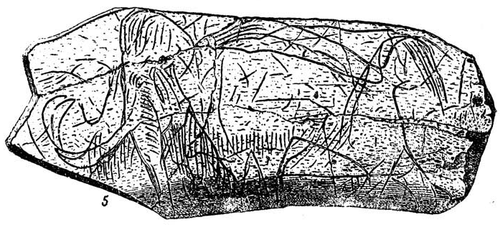Holly Oak Gorget: Difference between revisions
mNo edit summary |
mNo edit summary |
||
| Line 9: | Line 9: | ||
A gorget or pendant is a sort of decorative necklace worn to display a person’s status. In Native American culture, it is common for a gorget to be carved out of materials such as shells, mollusks, gourds, etc. [3]. Different gorgets commonly show a person’s status within their tribe. Carvings can be related to family origins or tribe symbols. Because gorgets hold such great information about the tribe or owner who wore it, they are important archaeological finds. They can tell us many things about who wore the gorget, where it was carved, and the ancient community around the owner. In the example of the Holly Oak Gorget, if it were not fabricated, we could assume that the owner who wore the gorget encountered woolly mammoths, as that is what is carved into it. | A gorget or pendant is a sort of decorative necklace worn to display a person’s status. In Native American culture, it is common for a gorget to be carved out of materials such as shells, mollusks, gourds, etc. [3]. Different gorgets commonly show a person’s status within their tribe. Carvings can be related to family origins or tribe symbols. Because gorgets hold such great information about the tribe or owner who wore it, they are important archaeological finds. They can tell us many things about who wore the gorget, where it was carved, and the ancient community around the owner. In the example of the Holly Oak Gorget, if it were not fabricated, we could assume that the owner who wore the gorget encountered woolly mammoths, as that is what is carved into it. | ||
[[File:mammoth_carved_on_ivory.png|500px|thumb|La Madeleine | [[File:mammoth_carved_on_ivory.png|500px|thumb|La Madeleine]] | ||
===La Madeleine=== | ===La Madeleine=== | ||
Revision as of 22:58, 5 December 2019
By Haley Allgeyer
In 1889, Hilborne T. Cresson announced that he had allegedly discovered the Holly Oak Gorget. He declared that the gorget was discovered by himself in 1864, at an archaeological site in northern Delaware [1]. The Holly Oak Gorget is a shell pendant, worn as a necklace, with a carving in it of what appears to by a woolly mammoth. The shell is made of busycon sinistrum, a sea snail, often found along the United States coast of the Atlantic Ocean.

History
Gorgets
A gorget or pendant is a sort of decorative necklace worn to display a person’s status. In Native American culture, it is common for a gorget to be carved out of materials such as shells, mollusks, gourds, etc. [3]. Different gorgets commonly show a person’s status within their tribe. Carvings can be related to family origins or tribe symbols. Because gorgets hold such great information about the tribe or owner who wore it, they are important archaeological finds. They can tell us many things about who wore the gorget, where it was carved, and the ancient community around the owner. In the example of the Holly Oak Gorget, if it were not fabricated, we could assume that the owner who wore the gorget encountered woolly mammoths, as that is what is carved into it.

La Madeleine
In 1864, Edouard Lartet discovered La Madeleine pendant which depicts a woolly mammoth carving, very similar to the Holly Oak carving [2]. Though, Hilborne T. Cresson claims he discovered the Holly Oak Gorget prior to public discovery of La Madeleine, Cresson did not speak of his finding until after La Madeleine made the news. After La Madeleine was discovered, both the pendant, and Lartet received lots of attention. Because of the vast amount of attention that Lartet’s discovery received, reputable archaeologists have reason to believe that Cresson was after the similar fame and fortune [2]. The context in which the Holly Oak Gorget was “discovered” is important in understanding how and why it was falsified. Trends of fame and fortune will always spark people to follow and create their own fame, but the ways in which they do this can be harmful to real archaeological finds.
Pseudoarchaeological Claims
Hilborne T. Cresson
During the time of both La Madeleine discovery and the Holly Oak Gorget discovery, Hilborne T. Cresson worked as a field assistant at Harvard University’s Peabody Museum of Archaeology and Ethnology[1]. This background did help build his claim, though despite this, his “discovery” was never taken seriously by archaeologists.
Forgotten Controversy
John Kraft and Ronald Thomas
The Truth
There are many problems revealing exactly why the Holly Oak Gorget was falsified by Hilborne T. Cresson. These problems involve radiocarbon dating of the shell, similarities to La Madeleine, and how Cresson announced his discovery.
Hilborne T. Cresson's Crimes
We know that Hilborne T. Cresson’s archaeological “discovery” was never taken seriously by reputable archaeologists, and it still is not today. One big reason for this is his personal and criminal history. In 1891, he was actually fired from the museum after being accused of stealing from archaeological sites [2].
Issues
References
Griffin, James B., Meltzer, David J., Smith, Bruce D., Sturtevant, William C.
1988 A Mammoth Fraud in Science. American Antiquity, 53(3), 578-582. doi:10.2307/281218
Jochim, Michael A.
1985 American Anthropologist, 87(1), new series, 158-160.